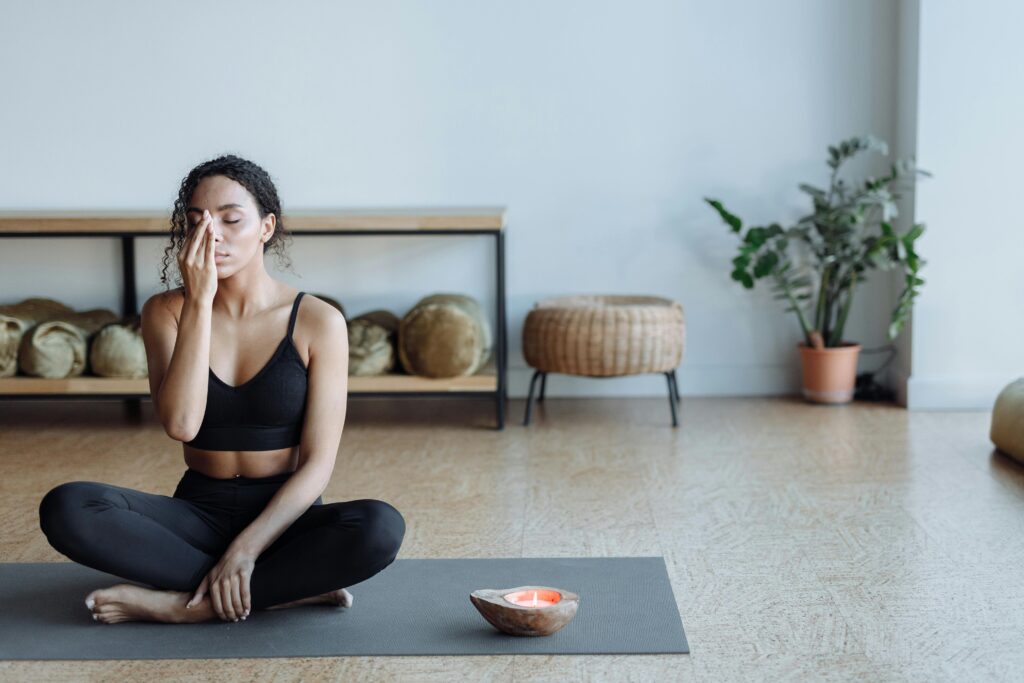Are you trying to change your existing habits or introduce new ones, but can’t seem to make them stick? You are not alone. Building consistent habits is tough, especially when life gets busy. While some people seem to adopt new routines with ease, most of us require a little strategy, such as habit stacking, to support our fitness journey.
Habit stacking is a simple yet surprisingly effective method. This technique involves attaching a new habit to something you already do, like brushing your teeth or making coffee, so it becomes easier to remember and repeat.
Here’s how habit stacking works and how you can use it to finally make fitness part of your daily routine.
What is Habit Stacking and How Does it Work?
The term “habit stacking” is relatively new. Author S.J. Scott introduced the concept in his book, Habit Stacking: 127 Small Changes to Improve Your Health, Wealth, and Happiness. Later on, psychology writers like Charles Duhigg and James Clear helped bring it into the mainstream.
Habit stacking is a behavior change technique that involves linking a new habit to something you already do consistently. The existing habit becomes a cue or trigger, making it easier to remember and follow through. It’s a specific form of implementation intentions and goal achievement, but instead of anchoring your habit to a time or place, you anchor it to another habit.
For example, if you regularly brew coffee in the morning, you might stretch for five minutes while it brews. That way, you are not forcing a new habit into your day; you are building it into something you are already doing. It reduces friction, making the behavior feel natural.
5 Benefits of Habit Stacking in Fitness
Habit stacking is a powerful strategy for building a fitness routine that actually sticks. By pairing new habits with ones you already do daily, you remove guesswork, reduce resistance, and make change feel manageable. Here are five key benefits of this approach and why it works so well.
1. It simplifies your routine.
When your new habit is tied to something you already do, it’s easier to remember and act on. And this doesn’t require extra planning.
For example, if you always brush your teeth after waking up, you can follow it with a quick set of squats or a glass of water. That familiar cue becomes your launchpad.
By keeping things simple and tied to existing behavior, habit stacking cuts through decision fatigue, making your routine more predictable.
2. It helps habits stick.
Consistency relies on repetition, and context and habit stacking provide both.
Let’s say you want to start meditating daily. If you stack it right after your morning coffee, you’re more likely to follow through because you’re already in a steady rhythm.
The more you repeat the stack, the more authentic it becomes. And over time, one strong habit can trigger a chain of healthy behaviors.
3. It boosts productivity.
By combining small actions into one continuous flow, you make better use of your time and energy. For instance, while waiting for your oatmeal to heat up, you could use that minute to do calf raises or breathing exercises.
These micro-moments of movement add up, helping you layer wellness into everyday activities without needing a full workout block.
4. It strengthens your self-discipline.
Discipline grows when you prove to yourself that you can follow through, especially on small, consistent actions.
When you habit stack, you eliminate the need for willpower. You don’t have to “decide” to stretch or hydrate; it just follows brushing your teeth or turning off your alarm.
Over time, this structure becomes second nature, and that self-discipline starts to carry over into bigger fitness goals.
5. It builds confidence and motivation.
Every small win creates positive reinforcement. That momentum gives you the motivation to keep going. If you stack a 2-minute plank onto your evening wind-down routine and stick to it for a week, you will likely start feeling more capable and committed to your fitness journey.
Habit stacking provides you with proof, not just hope, that you can follow through, which naturally boosts your confidence and keeps you motivated.
How to Habit Stack and Create a New Fitness Routine?
If you are trying to build new fitness habits, one of the easiest ways to make them stick is by linking them to something you already do every day. This is the core idea behind habit stacking: it lowers resistance and helps new behaviors feel automatic.
For example, instead of forcing yourself to “remember to stretch,” you could attach that action to brushing your teeth or brewing your coffee. It feels less like a chore and more like a natural extension of your routine.
Here’s how you can build a habit stack that actually works and lasts.
1. Identify all potential goals and cues.
Start by getting clear on what you actually want to change. When your goals are vague, your habits will follow too.
Let’s say you want to “get healthier,” but that’s too broad to build on. But if your goal is to stretch for 5 minutes each morning or drink more water before lunch, now you’re working with something stackable.
Clarifying your goals and identifying when you already have consistent cues in your day, like brushing your teeth or making lunch, sets the stage for a successful stack.
2. Decide which habit to stack.
Choose a habit that fits naturally with something you already do. The smoother the pairing, the better the chance it sticks.
For instance, if you always make coffee in the morning, that’s a perfect cue. You could stretch while the kettle boils or do five squats before your first sip. Small, logical combinations like these reduce friction and keep things flowing.
The key here is compatibility. If the two habits feel like they belong together, your brain will link them faster, making repetition easier and progress feel automatic.
3. Be specific.
Vague habits are hard to follow. Specific habits stick.
Saying “I’ll work out more” is easy to forget. But saying “I’ll do 10 push-ups after brushing my teeth is clear, measurable, and easy to track. Specificity removes ambiguity and boosts accountability.
If you know exactly what action you’re doing, how long it takes, and when it happens, you are far more likely to follow through. And when life gets unpredictable? Have a backup plan in place. (E.g., if you miss your morning cue, repeat the habit after lunch instead).
4. Start small.
Start small, really small. Big goals are exciting, but tiny actions are what build momentum.
Why? Because small habits are easier to repeat. And repetition is what creates change.
Example: If your goal is to stay hydrated, stack it with a cue like brushing your teeth: “After brushing, I’ll drink a glass of water.” That’s short, clear, and doable.
Over time, these mini habits become part of a chain. Each step reinforces the next, and consistency becomes effortless.
5. Set a timeline.
Setting a timeline helps give your habit stack direction. Without one, even the best habit can lose momentum.
For example, committing to “stretch every morning for the next 30 days” provides a clear milestone to aim for and a reason to keep going. Deadlines tied to events (like a 5K race or yoga class) can also motivate you to follow through.
It doesn’t have to be strict, but having a time-based goal keeps you accountable and adds a sense of progress.
6. Track your progress.
Tracking your habits provides visible proof of progress, which can be incredibly motivating.
Whether you use a journal, a habit-tracking app, or a simple calendar with check marks, the act of logging your behavior reinforces your commitment. You are no longer just “trying,” you are seeing consistency stack up.
Each checkmark, journal entry, or streak on your app is a mini win. And those wins remind you that the effort is paying off, even if it doesn’t feel dramatic day to day.
Morning Routine Tips for Habit Stacking
These quick examples can help spark ideas. The formula is simple: take one habit you already do and stack a new one right after or alongside it.
- After I turn off my alarm, I will do 5 minutes of stretching.
- After waking up, I will do at least 1 minute of guided breathing techniques.
- While brewing my coffee, I will do 10 calf raises, squats, or lunges.
- After brewing my coffee, I will do 10 push-ups on the countertop.
- After grabbing my morning beverage (coffee, tea, or hot lemon water), I will go to a quiet room and practice stress meditation for 5 to 10 minutes.
- After finishing my coffee, I will grab my water bottle and head out for a 5 to 10-minute walk.
- While brushing my teeth, I will do calf raises on each leg for the full 2 minutes.
- While watching TV, I will do some stretching or bounce on an exercise ball.
- While walking my dog, I will jog lightly for 5 to 10 minutes.
- After a cool down from my home workout, I will do some foam rolling recovery.
- While in the shower, I will do a quick full-body stretch.
These examples are effective because they are specific, concise, and easy to recall. The right cue makes all the difference. When you choose a habit that already happens daily, you create a natural trigger that reinforces your new routine.
The more immediate and specific your cue, the easier it is to stay consistent. With enough repetition, your habit stack becomes second nature.
Final Thought
If you have struggled to make new fitness habits stick, habit stacking could be the solution you need. The idea is simple: pair something you already do with something you want to do, then repeat it until it becomes automatic.
It’s not a magic hack, and it won’t always feel easy. But with consistency and patience, habit stacking can turn scattered attempts into a sustainable daily routine. Start small, stay consistent, and let your habits build on each other. One stack at a time.
Frequently Asked Questions
Here are the commonly asked questions about habit stacking for a fitness routine.


